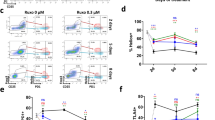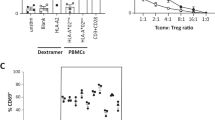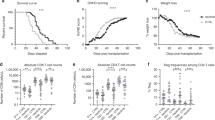Abstract
Rapamycin (RAPA) is an immunosuppressive drug that prevents and treats graft-versus-host disease (GVHD) after allogeneic hematopoietic cell transplant (HCT). One possible mechanism for its efficacy is induction of tolerance, through increased number or enhanced survival of regulatory T cells. In our experiments, B10.D2 BM and splenocytes were injected into lethally irradiated BALB/cJ recipients. The mice received i.p. injections of either RAPA or vehicle control on days 1–28. There was a significant survival advantage in RAPA-treated mice. Evaluation of the skin biopsies showed a dense cellular infiltrate in RAPA-treated mice. Further characterization of these cells revealed a higher percentage of regulatory T cells characterized by FoxP3-positive cells in high-dose RAPA-treated mice as compared with controls on day 30. This effect appears to be dose dependent. When peripheral blood analysis for FoxP3-positive cells was performed, there was no significant difference observed in the RAPA-treated mice as compared with control mice. These data show a novel mechanism of rapamycin in GVHD, accumulation of regulatory T cells in the GVHD target tissue: the skin.
This is a preview of subscription content, access via your institution
Access options
Subscribe to this journal
Receive 12 print issues and online access
$259.00 per year
only $21.58 per issue
Buy this article
- Purchase on Springer Link
- Instant access to full article PDF
Prices may be subject to local taxes which are calculated during checkout






Similar content being viewed by others
References
Blazar BR, Taylor PA, Panoskaltsis-Mortari A, Vallera DA . Rapamycin Inhibits the Generation of Graft-Versus-Host Disease- and Graft-Versus-Leukemia-Causing T Cells by Interfering with the Production of Th1 or Th1 Cytotoxic Cytokines. J Immunol 1998; 160: 5355–5365.
Couriel DR, Saliba R, Escalon MP, Hsu Y, Ghosh S, Ippoliti C et al. Sirolimus in combination with tacrolimus and corticosteroids for the treatment of resistant chronic graft-versus-host disease. Br J Haematol 2005; 130: 409–417.
Antin JH, Cutler C . Sirolimus for GVHD prophylaxis in allogeneic stem cell transplantation. Bone Marrow Transplantation 2004; 34: 471–476.
Chen BJ, Morris R, Chao NJ . Graft-Versus-Host Disease Prevention by Rapamycin: Cellular Mechanisms. Biol Blood Marrow Transplant 2000; 6: 529–536.
Noris M, Casiraghi F, Todeschini M, Cravedi P, Cugini D, Monteferrante G et al. Regulatory T cells and T cell depletion: role of immunosuppressive drugs. J Am Soc Nephrol 2007; 18: 1007–1018.
Antin JH, Kim HT, Cutler C, Ho VT, Lee SJ, Miklos DB et al. Sirolimus, tacrolimus, and low-dose methotrexate for graft-versus-host disease prophylaxis in mismatched related donor or unrelated donor transplantation. Blood 2003; 102: 1601–1605.
Cutler C, Li S, Ho VT, Koreth J, Alyea E, Soiffer RJ et al. Extended follow-up of methotrexate-free immunosuppression using sirolimus and tacrolimus in related and unrelated donor peripheral blood stem cell transplantation. Blood 2007; 109: 3108–3114.
Valmori D, Tosello V, Souleimanian NE, Godefroy E, Scotto L, Wang Y et al. Rapamycin-mediated enrichment of T cells with regulatory activity in stimulated CD4+ T cell cultures is not due to the selective expansion of naturally occurring regulatory T cells but to the induction of regulatory functions in conventional CD4+ T cells. J Immunol 2006; 177: 944–949.
Powell JD, Lerner CG, Schwartz RH . Inhibition of cell cycle progression by rapamycin induces T cell clonal anergy even in the presence of costimulation. J Immunol 1999; 162: 2775–2784.
Turnquist HR, Raimondi G, Zahorchak AF, Fischer RT, Wang Z, Thomson AW . Rapamycin-conditioned dendritic cells are poor stimulators of allogeneic CD4+ T cells, but enrich for antigen-specific foxp3+ T regulatory cells and promote organ transplant tolerance. J Immunol 2007; 178: 7018–7031.
Battaglia M, Stabilini A, Roncarolo M-G . Rapamycin selectively expands CD4+CD25+FoxP3+ regulatory T cells. Blood 2005; 105: 4743–4748.
Battaglia M, Stabilini A, Migliavacca B, Horejs-Hoeck J, Kaupper T, Roncarolo M-G . Rapamycin promotes expansion of functional CD4+CD25+FOXP3+ regulatory T cells of Both Healthy Subjects and Type 1 Diabetic Patients. J Immunol 2006; 177: 8338–8347.
Zeiser R, Leveson-Gower DB, Zambricki EA, Kambham N, Beilhack A, Loh J et al. Differential impact of mammalian target of rapamycin inhibition on CD4+CD25+Foxp3+ regulatory T cells compared with conventional CD4+ T cells. Blood 2008; 111: 453–462.
Strauss L, Whiteside TL, Knights A, Bergmann C, Knuth A, Zippelius A . Selective survival of naturally occurring human CD4+CD25+Foxp3+ regulatory T cells cultured with rapamycin. J Immunol 2007; 178: 320–329.
Ermann J, Hoffmann P, Edinger M, Dutt S, Blankenberg FG, Higgins JP et al. Only the CD62 L+ subpopulation of CD4+CD25+ regulatory T cells protects from lethal acute GVHD. Blood 2005; 105: 2220–2226.
Wysocki CA, Jiang Q, Panoskaltsis-Mortari A, Taylor PA, McKinnon KP, Su L et al. Critical role for CCR5 in the function of donor CD4+CD25+ regulatory T cells during acute graft-versus-host disease. Blood 2005; 107: 3300–3307.
Hoffmann P, Ermann J, Edinger M, Fathman CG, Strober S . Donor-type CD4+CD25+ Regulatory T Cells Suppress Lethal Acute Graft-Versus-Host Disease after Allogeneic Bone Marrow Transplantation. J Exp Med 2002; 196: 389–399.
Rieger K, Loddenkemper C, Maul J, Fietz T, Wolff D, Terpe H et al. Mucosal FOXP3+ regulatory T cells are numerically deficient in acute and chronic GvHD. Blood 2006; 107: 1717–1723.
Nguyen VH, Zeiser R, Negrin RS . Role of naturally arising regulatory T cells in hematopoietic cell transplantation. Biol Blood Marrow Transplant 2006; 12: 995–1009.
Schneider M, Munder M, Karakhanova S, Ho AD, Goerner M . The initial phase of graft-versus-host disease is associated with a decrease of CD4+CD25+ regulatory T cells in the peripheral blood of patients after allogeneic stem cell transplantation. Clin Lab Hematol 2006; 28: 382–390.
Nakamura T, Shima T, Saeki A, Hidaka T, Nakashima A, Takikawa O et al. Expression of indoleamine 2, 3-dioxygenase and the recruitment of Foxp3-expressing regulatory T cells in the development and progression of uterine cervical cancer. Cancer Sci 2007; 98: 874–881.
Bamias G, Okazawa A, Rivera-Nieves J, Arseneau KO, De La Rue SA, Pizarro TT et al. Commensal bacteria exacerbate intestinal inflammation but are not essential for the development of murine ileitis. J Immunol 2007; 178: 1809–1818.
Keever-Taylor CA, Browning M, Johnson B, Truitt R, Bredeson C, Behn B et al. Rapamycin enriches for CD4(+) CD25(+) CD27(+) Foxp3(+) regulatory T cells in ex vivo-expanded CD25-enriched products from healthy donors and patients with multiple sclerosis. Cytotherapy 2007; 9: 144–157.
Zeiser R, Nguyen VH, Beilhack A, Buess M, Schulz S, Baker J et al. Inhibition of CD4+CD25+ regulatory T-cell function by calcineurin-dependent interleukin-2 production. Blood 2006; 108: 390–399.
Hackstein H, Taner T, Zahorchak AF, Morelli AE, Logar AJ, Gessner A et al. Rapamycin inhibits IL-4—induced dendritic cell maturation in vitro and dendritic cell mobilization and function in vivo. Blood 2003; 101: 4457–4463.
Hackstein H, Taner T, Logar AJ, Thomson AW . Rapamycin inhibits macropinocytosis and mannose receptor-mediated endocytosis by bone marrow-derived dendritic cells. Blood 2002; 100: 1084–1087.
Woltman AM, van der Kooij SW, Coffer PJ, Offringa R, Daha MR, van Kooten C . Rapamycin specifically interferes with GM-CSF signaling in human dendritic cells, leading to apoptosis via increased p27KIP1 expression. Blood 2003; 101: 1439–1445.
Nguyen VH, Zeiser R, daSilva DL, Chang DS, Beilhack A, Contag CH et al. In vivo dynamics of regulatory T-cell trafficking and survival predict effective strategies to control graft-versus-host disease following allogeneic transplantation. Blood 2007; 109: 2649–2656.
Kang SG, Lim HW, Andrisani OM, Broxmeyer HE, Kim CH . Vitamin a metabolites induce gut-homing FoxP3+ regulatory T cells. J Immunol 2007; 179: 3724–3733.
Acknowledgements
Many thanks to Zouwei Su, PhD, for his help in the preparation of the histopathology.
Author information
Authors and Affiliations
Corresponding author
Rights and permissions
About this article
Cite this article
Palmer, J., Chen, B., DeOliveira, D. et al. Novel mechanism of rapamycin in GVHD: increase in interstitial regulatory T cells. Bone Marrow Transplant 45, 379–384 (2010). https://doi.org/10.1038/bmt.2009.140
Received:
Revised:
Accepted:
Published:
Issue Date:
DOI: https://doi.org/10.1038/bmt.2009.140
Keywords
This article is cited by
-
A neuro-swarming intelligent heuristic for second-order nonlinear Lane–Emden multi-pantograph delay differential system
Complex & Intelligent Systems (2022)



